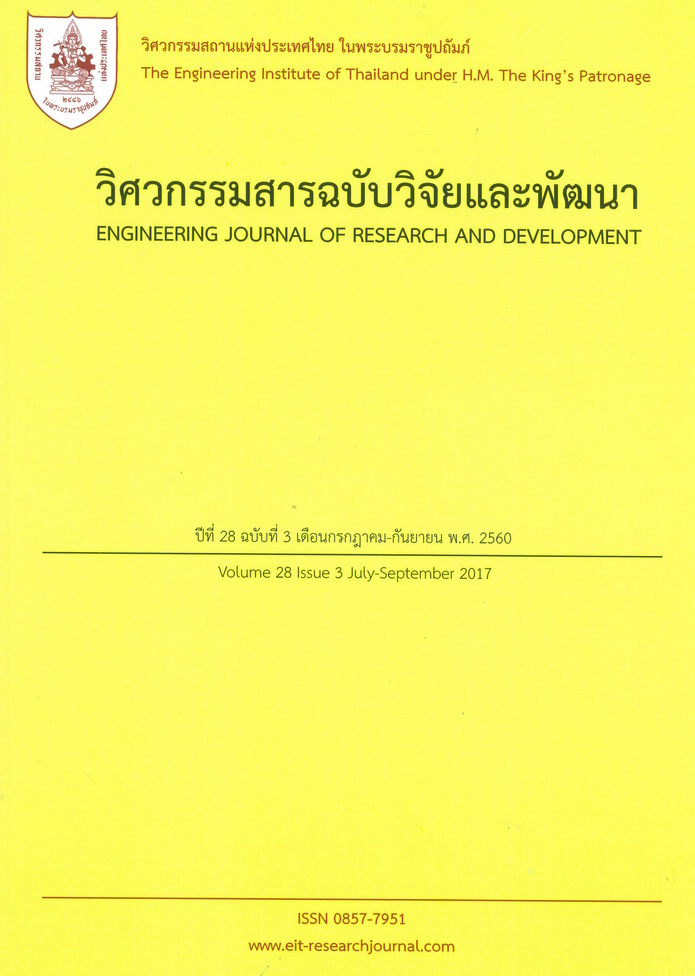TIME-DEPENDENT TENSILE STRENGTHS OF ROCK SALT AS AFFECTED BY CARNALLITE CONTENTS
Main Article Content
Abstract
การศึกษานี้มีวัตถุประสงค์เพื่อหากำลังดึงเชิงเวลาของเกลือหินที่มีผลกระทบจากการเจือปนของแร่คาร์นัลไลต์ (C%) การทดสอบการดัดงอแบบสี่จุดได้ดำเนินการโดยใช้แท่งตัวอย่างของโพแทชขนาด 50´50´200 มิลลิเมตร มีการผันแปรปริมาณแร่คาร์นัลไลต์จากร้อยละ 0 ถึง ร้อยละ 95 อัตราการให้แรงกดที่สอดคล้องกับการเพิ่มขึ้นของความเค้นดึงที่จุดแตกอยู่ในช่วงระหว่าง 10-6 ถึง 10-3 เมกะปาสคาลต่อวินาที ระหว่างการทดสอบมีการตรวจวัดความเครียดดึงอย่างต่อเนื่อง ณ จุดที่จะเกิดการแตกภายใต้แรงดึง ผลการทดสอบระบุว่าค่ากำลังดึง (st) ของตัวอย่างหินมีค่าลดลงเมื่อมีการเพิ่มขึ้นของปริมาณแร่คาร์นัลไลต์และเมื่อมีการลดลงของอัตราการให้แรงดึง (sR) การผันแปรนี้สามารถอธิบายได้ด้วยสมการ st = 8.21× exp [-0.02 C%] (sR) × 0.17 เมกะปาสคาล ทั้งนี้การทดสอบได้มีการคำนวณค่าพลังงานความเครียดที่จุดแตก (W) และพัฒนาให้อยู่ในฟังก์ชั่นของ C% โดย W = 2.17× exp [-0.03 C%] กิโลปาสคาล แม็กเวลโมเดลถูกนำมาใช้เพื่ออธิบายการขึ้นกับเวลาของความเครียดดึงที่ตรวจวัดได้จากการทดสอบ ความยืดหยุ่นและความหนืดของตัวอย่างหินได้ถูกสอบเทียบจากค่าที่ได้จึงส่งผลให้สามารถร่างแผนภูมิของความเครียดดึงเชิงเวลาภายใต้ความเค้นดึงที่ผันแปร
This study aims at determining the time-dependent tensile strengths of rock salt under varying carnallite contents. Four-point bending tests are performed on prismatic beams (50×50×200 mm) of potash specimens with carnallite contents ranging from 0 to 95%. The applied loading rates are equivalent to the induced tensile stress rates at the crack initiation point ranging from 10-6 to 10-3 MPa/s. The tensile strains are monitored at the point where the incipient tensile crack is induced. The results indicate that tensile strengths (st) decrease when the carnallite contents (C%) increase and the stress rates (sR) decrease, which can be best represented by an empirical equation: st = 8.21× exp [-0.02 C%] (sR) × 0.17 MPa. The strain energy at failure (W) has been calculated and derived as a function of C%, which can be described by: W = 2.17× exp [-0.03 C%] kPa. The Maxwell model is used to describe the time-dependent tensile strain of the specimens. Its tensile elasticity and viscosity are calibrated by regression analysis of the test results, and hence series of tensile strain-time curves can be constructed for various applied tensile stresses.
Article Details
The published articles are copyright of the Engineering Journal of Research and Development, The Engineering Institute of Thailand Under H.M. The King's Patronage (EIT).

